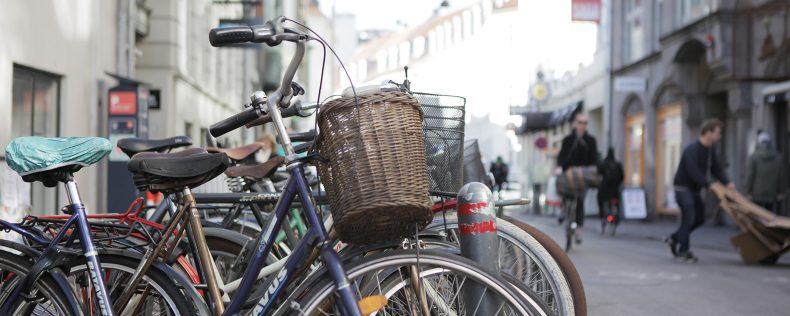Copenhagen as a Biking City
Copenhagen is famous for its biking culture, with approximately 500,000 Copenhageners choosing to bike every day. So, why do the locals bike? Some say it’s good exercise, it helps the environment, or it saves money, while others bike for its simple convenience. The beauty of biking is that it fulfills and satisfies everyone in a different way, yet it unifies Copenhageners on a common ground.
Getting lost on bicycle adventures is the perfect way to discover new areas and experience urban life as a local. On two wheels, you can explore all over the city in an afternoon.
Video: How to Bike in Copenhagen
Helmet Safety
DIS strongly encourages you to wear a helmet while biking. Helmets can be purchased at bike shops, as well as larger supermarkets like Føtex and Kvickly. Not sure what size helmet you need? Using a tape measure, wrap it about one inch above your eyebrows, then match those measurements with the sizes below:
- Small: 20″-21.75″ (51cm-55cm)
- Medium: 21.75″-23.25″ (55cm-59cm)
- Large: 23.25″-24.75″ (59cm-63cm)
Avoiding Theft
- Always lock your bike via your back wheel lock. For additional security, buy an extra chain lock so you can lock it to something
- When going out at night, park your bike a bit away from the venue entrance, as it less likely to get stolen
- Avoid leaving your bike at main transportation stations (i.e. Nørreport or Central Station) for long periods of time
Parking Near DIS
- There is a bike parking area for students and staff in Vestergade 10, through the courtyard and to the right (marked with a bicycle symbol). The bike parking in Vestergade 8 is designated for staff and faculty only
- Bike parking right at DIS is not guaranteed, but there are plenty of places around DIS where you can park your bike (i.e. Gammeltorv or side streets)
Where Can You Bring Your Bike?
You can take your bike on most forms of public transportation, but there are some restrictions. If you are caught in violation of these restrictions (i.e. you do not purchase a valid ticket, you ride during restricted hours), you will be required to pay a fine. See the overview below of where and when you can take your bike and the costs (if any) associated with the various forms of public transportation. Note that you cannot purchase bike tickets from the DSB app – bike tickets must be purchased from a kiosk at a station.
| Means of Transportation | Can I Bring My Bike? | Cost? |
| Metro | Yes, but not during rush hour (7:00-9:00, 15:30-17:30) | 12 DKK (special ticket) |
| S-Tog | Yes, but you are not allowed to get on or off the train at Nørreport Station during rush hours (7:00-9:00, 15:30-17:30 on weekdays). When you are at the station, stand on the platform where there are bike symbols painted on the floor and then be sure to get in one of the bike cars (have bikes painted on the side) | Free |
| Regional/InterCity Train | Yes, but specific regulations depends on the type of train. Note that you are not allowed to get on or off the train at Nørreport Station during rush hours (7:00-9:00, 15:30-17:30 on weekdays). When you are at the station, stand on the platform where there are bike symbols painted on the floor and then be sure to get in one of the bike cars (have bikes painted on the side) | Price depends on the route and how long you are traveling. Bike ticket can be purchased at the station |
| Bus | Yes, but not during rush hour (7:00-9:00 and 15:30-17:30), and provided there is space. People generally do not bring their bikes on buses in Copenhagen | Free |
|
Harbor Bus |
Yes | Free |
| Taxi | Yes – they carry bike holders in their trunks and can attach a few bikes to the back of their car | Additional 20 DKK to your ride fee |
Biking Regulations and Tips
It is your responsibility to familiarize yourself with Danish laws. However, here are a few common regulations (note: this is not an exhaustive list):
Breaking the following laws results in a 700 DKK fine:
- Riding without lights (front and back) whenever the streetlights are on (while it’s dark)
- Biking with two people on a one-person bike
- Biking on sidewalks, walking paths, or over crosswalks (where there are striped markings)
- Failure to use bike signals when stopping and turning
- Biking in the opposite direction on bike paths
- Biking without hands on the handlebars
Breaking the following laws results in a 1000 DKK fine:
- Running a red light
- Turning right at a red light
- Making a left turn through an intersection, which is illegal (to turn left, you must proceed straight through the intersection to the opposite corner and wait until the light turns green)
- Biking against traffic on the roads
- Using your cell phone while biking
- Biking while under the influence of alcohol is illegal, resulting in a 1,500 DKK fine. While there is no set limit, police officers will self-evaluate whether they deem you a danger to yourself and others
Other useful tips:
- While a helmet is not required by law, it is strongly recommended
- The bike must be locked when parked. If you fail to lock your bike, it will not be covered by insurance if stolen
- When a bus stops, bikers must stop to allow passengers to enter or exit the bus
- Bikes are allowed on the S-tog for free (at the station, stand on the platform where there are bikes painted on the floor and then be sure to get in the bike compartment), but a ticket must be purchased when riding regional trains and the metro
For more tips, refer to the DIS bike manual.
